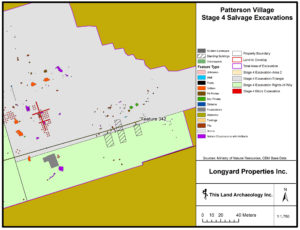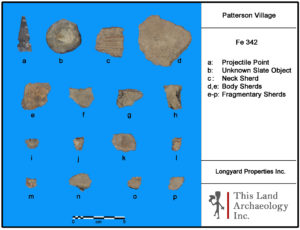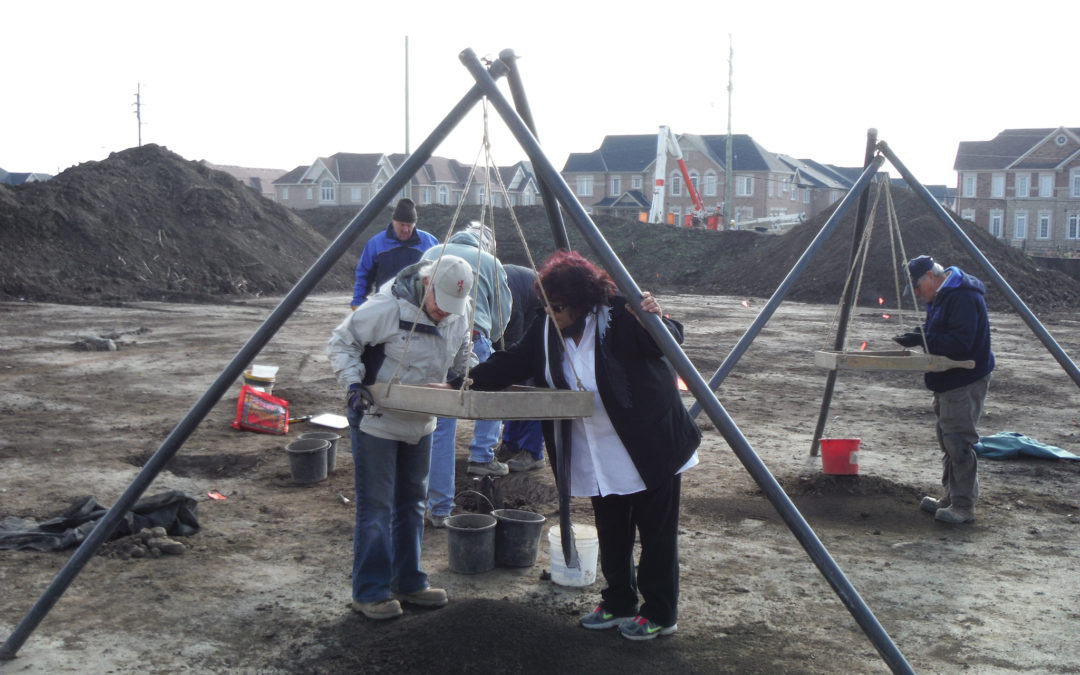Patterson Village continues to present new and fascinating discoveries. This  week we discuss a feature which appears to be a unique find in excavations in southern Ontario. Since 2006, the majority of our work has been east of the Niagara Escarpment. It is there we worked on two Huron-Wendat villages occupied prior to about 1500 A.D., both of which had been partially excavated by others. Our previous indigenous artifact discoveries have consisted of single arrow points, or spear points lost while hunting. Or a scatter of chert fragments, perhaps from sharpening a tool. Yes, these particular finds are interesting, however, they usually do not require further investigations under the Standards and Guidelines mandated by the Ministry of Tourism Culture and Sport. We were hoping to dig a little deeper, so to speak.
week we discuss a feature which appears to be a unique find in excavations in southern Ontario. Since 2006, the majority of our work has been east of the Niagara Escarpment. It is there we worked on two Huron-Wendat villages occupied prior to about 1500 A.D., both of which had been partially excavated by others. Our previous indigenous artifact discoveries have consisted of single arrow points, or spear points lost while hunting. Or a scatter of chert fragments, perhaps from sharpening a tool. Yes, these particular finds are interesting, however, they usually do not require further investigations under the Standards and Guidelines mandated by the Ministry of Tourism Culture and Sport. We were hoping to dig a little deeper, so to speak.
We recognized that an arrowhead found in a dark stain in the subsoil—which, at first, we interpreted as a natural depression filled with topsoil—might contain more indigenous artifacts. We immediately ceased further work until we could reach a monitor from Georgina Island First Nation to participate in the completion of the excavation of this exciting feature. To our delight, we uncovered 20 pieces of one or more pottery vessels, and an unknown slate object in the fill of this feature. What makes this an uncommon find is the fact that there was no visible evidence of indigenous artifacts on the surface in this area. Furthermore, there were no additional features in this area which contained indigenous artifacts. As you can imagine, we were puzzled.
After careful consideration, I’ve concluded that these artifacts represent a small collection of indigenous artifacts made on a Huron-Wendat village located near Patterson Village. I believe, at some point this collection was discarded in a natural soil depression east of House 18.
There is an intriguing Huron-Wendat village documented to the north of Patterson Village which may be the source of this unique collection of artifacts. Particularly interesting is, at the time Peter Patterson bought his land, it was recorded that the lot was covered in large pine trees. Since pine trees regenerated on the agricultural fields of Huron-Wendat villages, I knew that there had to be a village nearby. In my previous career as a scholar, the research on Indigenous sites relied upon the presence of documented stands of large pine trees to predict the presence of villages.
There is never a dull moment on a dig. Have you ever come across a similar feature? If so, I’d love to hear from you to determine if this really is a unique find. Your comments and feedback are always welcome, and if you’d like to find out more about Patterson Village, check out the I C Bookstore.
Kindest Regards,
Bill Finlayson
William D. Finlayson, Midland, Ontario
Ontario’s Leading and Senior-Most Archaeologist and Author
